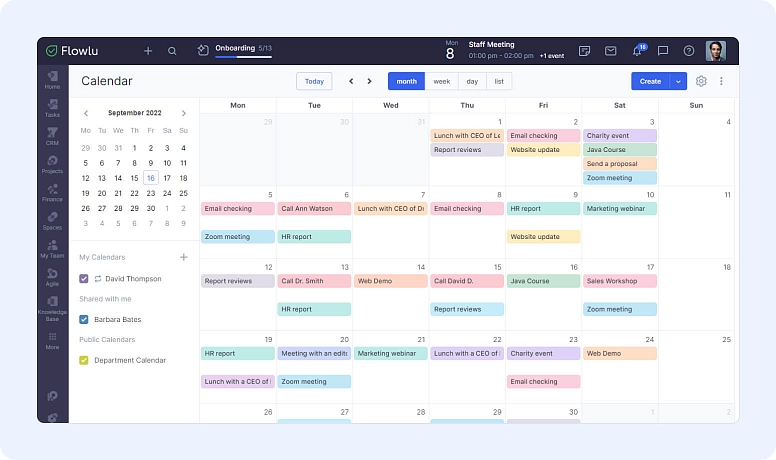How to Improve Time Management in Teamwork
However, time management for individuals and teams is different; you need to come up with a different approach and mindset. One of the things that is important to keep in mind is that strategies for time management and teamwork are important not only to help you work more efficiently and faster but also smarter.
By using different strategies and tools, you may then avoid distractions and focus on the most important tasks for the team. It’s also the right way to effectively organize regular workload and check its progress.
Developing Strategies: The Importance of Time Management in Teamwork
When you're not making the best use of your time your work can be more difficult and efficiency is lost. But that's not all. When you just can't complete your tasks on time, your stress levels start to rise and you may lose control of the assignment you're completing. The truth is that you have limited hours to complete your tasks. Between meetings, tasks lists, and other schedules, it’s essential that you access different techniques. This is why time management strategies are so important.
But time management shouldn't be seen only for the individual but for the team as well. More and more business owners and leaders start to agree that they do influence the way their employees manage their time. Leaders need to take a step forward and train their teams to develop strategies for time management. Ultimately, when you think about group work time management you need to think about how a leader runs a project and how the different team members execute tasks. The main goal is to ensure everyone has the time to complete tasks but, at the same time, discourage outside work and procrastination.
4 Skills to Maintain Team and Time Management in the Workplace
#1: Communication
Communication between leaders and teams is crucial and it goes in both ways. It's important that leaders can easily communicate with team members and make them feel comfortable when they have questions, and participants need to be able to tell their leaders how the project is going.
#2: Setting Goals
When the leader sets a goal, team members know exactly what is expected from them. Ultimately, leaders create real expectations but more than this, leaders will also have an easier job when allocating resources.
#3: Prioritizing Tasks
Prioritization is always important to ensure that projects are completed on time. This is mainly a leader's work. Nevertheless, team workers may help define the tasks list as well as determine who's the best one to be in charge.
#4: Accountability
In the business world, accountability is a must. Everyone needs to be responsible for their part in the project. Accountability is also good to avoid disagreements and ensure everyone is engaged.
6 Benefits of Team Work and Time Management
#1: Better Team Efficiency
When you are using time management strategies for teams, you'll realize that delays on projects will be substantially reduced or will even disappear. With a detailed plan and with each team member knowing what he needs to do and how much time he has, tasks will start to be completed sometimes sooner than expected.
With Flowlu, everyone on the team can easily see the project timelines and who’s working on what. This transparency helps the group stay on the same page, cut down on delays, and get things done faster.
#2: Meet Due Dates
Projects will always be completed on time or even before the due date. With the right time management techniques and strategies or a similar tool, all co-workers will know how to prioritize their tasks and complete them on time.
#3: Improved Quality of Work
Tasks won't only be completed faster but better as well. The attention to detail that people can have will definitely improve the quality of the work delivered and reduce missed deadlines. This is a huge benefit.
#4: Less Stress
When there aren't any time management strategies in place, it's normal that team members may feel somewhat lost on what they have to do and when they have to complete their tasks. They don't know what needs to be performed by who and all these can be incredibly stressful. As you can easily understand, this can lead to issues with the quality of the tasks completed and even when they are completed.
When you are using time management strategies, everyone knows what needs to be done, by who, and when it needs to be completed. Everyone is accountable. Therefore, it is also easier for the leader to keep projects running. No matter if you take notes of what you need to do, need to turn to someone to help you, or reduce breaks, you’ll be more productive.
#5: Improve Collaboration
Collaboration is key to ensure that a group works well. When colleagues trust each other, when they know they can rely on others' work, everything runs smoothly. Besides, when a team learns to manage their time together, an extra bond is created and they can even learn from each other’s mistakes.
#6: Decrease Procrastination
We are certain that you agree that procrastination is one of the results of poor time management in a team. After all, when there aren't clear goals, it's easy to get distracted or not even know how to prioritize tasks.
With good time management, you'll be able to create routines that can improve the quality of work and decrease the time you spend on each task.
How To Set Up Effective Time Management Strategies
Simply put, time management can be defined as a mix of techniques and strategies that you define to help you define priorities, stop distractions, and stay focused on what you have to do. So, how can you put this into practice?
Step #1: Start with a plan
There’s no question that having a plan can make things a lot easier. Using a daily or weekly planner for tasks can truly boost productivity. After all, you’ll get a complete idea about what you need to do and when you need to finish. This is true for both individuals and teams.
As the team leader, you’re the one responsible to ensure that everyone is on the same page and know what they have to do within a specific timeframe. In addition, you may also consider using different communication channels so all participants know what’s expected from them and when. It’s important to deliver clear expectations and instructions.
You may identify the best time for a meeting, for example, to ensure that your teams can become more productive and that team members keep helping each other. This is also a good place to discuss and share the different features of the time management platform you are using. Instead of traditional meetings, you’ll notice that employees will look like they have more energy. They will even forget how they used to do things.
Using a tool like Flowlu helps you keep your plan clear and on track. It lets you see all the tasks, assign who’s doing what, and set deadlines. This way, the whole team can stay aligned and manage their time well. Plus, it has a chat feature, calendar, and GTD-planner task views to make everything easier to manage.
Step #2: Use a Team Schedule
Using a team schedule consistently is a great way to help each team member to know what they need to do at each point of the day. As the leader, you may be a great help with scheduling. After all, you know your team members. So, it will be easier to come up with a list of areas and responsibilities where each one is good and not so good. As soon as you gather all this information, you may then move forward.
You can start by identifying those workers who tend to work better together or those whose skills can complement each other. You may ask for opinions of your co-workers regarding the team schedule you came up with as well as you may create some availability charts where everyone can see who is available at a specific time. To ensure that all employees have what they need to complete their tasks, you may add the support and backup for roles and tasks in case they need.
Make sure that you answer all your team members' emails and solve any issue they might have. This allows them to feel comfortable that you are listening to their opinions and visions which means they are likely to be more motivated.
With Flowlu’s calendar and task management, you can set up a shared group schedule that shows deadlines, tasks, and key milestones. This keeps everyone on the same page and helps prioritize what needs to get done.
Step #3: Use a structure but don’t forget flexibility
While having a structure is crucial, you need to allow some space for flexibility. After all, things are changing all the time and you may need to adapt. The most important thing here is to actually find a plan or a process that works for both leaders and team members.
For example, you should listen to what your colleagues have to say regarding how they can prioritize their tasks to achieve the results you want. If they can accomplish this, why not let them set up their own plan or process?
One of the things that you may have a tendency to do is to set clear deadlines. After all, you need to deliver projects on a specific time frame. However, this isn’t the right way to think. Instead, you should set expectations.
Step #4: Cultivate support and teamwork
Some companies or businesses aren’t using proper time management strategies. And you may think that it’s your employee’s fault. However, in some cases, the error comes from the top of the organizations or companies. Sometimes, the top management may create an unproductive environment without realizing what they’re doing.
For example, some top managers believe that all employees need to answer their phones and email by the second, even if they’re not working at the time. As you can easily understand, this won’t work for much time. Instead, the top management needs to ensure that they have someone else who can fill the place of a sick employee, for example.
Step #5: Teach prioritization
As you know, prioritization is crucial in the workspace. And being able to empower your crew is a great way to make them feel good and, therefore, deliver high-quality work in less time. So, as a leader, you want to make sure that you teach your staff about work prioritization. You may help them at first but you should then provide them with the right tools to help them prioritize tasks on their own.
Step #6: Pass on overall business goals
One of the best things you can do for your company is to treat your employees well and with respect. But more than this, you want to make sure they feel they are a huge part of the company. So, when you pass on to them your business goals, they will be more tied to the company. As you can easily understand, this will lead to an increase in productivity.
Step #7: Document tasks
When you’re trying to improve time management for teams, you may consider document tasks. Simply put, the employee should communicate whenever a task is complete. When all your team members are doing this, it will be easier to see what you need to improve and what is already being done right.
Step #8: Give some freedom to your team
As a team leader, you need to know how to communicate well with each one of your team members. You know what are the strengths and weaknesses of each one and, one weakness most employees have is the inability to say no to a non-priority task when their schedule is already full. This is why giving them some freedom to decline these tasks is crucial.
Bottom Line
Team time management is crucial in the workplace. Since most businesses and companies rely on teams, you want to make sure they work well. But without proper time management, you’ll fail to meet many deadlines, not to mention that your employees may not be as motivated and focused as you think.
There are plenty of time management tools to choose from if you need them. For example, Flowlu has both free and paid versions. With features like task assignments, project tracking, and team chat, it helps you manage time and resources effectively, keeping the collaborators on track.
By using the right strategies, tools and techniques, you’ll see an increase in productivity on your team members as well as you’ll notice a better collaboration. But for this to happen it is important to have strong leadership. The team leader needs to be present to deliver what employees need and to give them the tools to work more independently.
You may use Flowlu, Slack, or Asana, for example to improve collaboration and the workflow. You may also use multiple time tracking tools to keep track of what has been done and what’s missing, among others.
Simply put, proper team time management helps you prioritize tasks, avoid procrastination, and focus on important tasks.
There are many different techniques and strategies you can use to prioritize tasks. One of the most popular ones is the Eisenhower matrix.




















